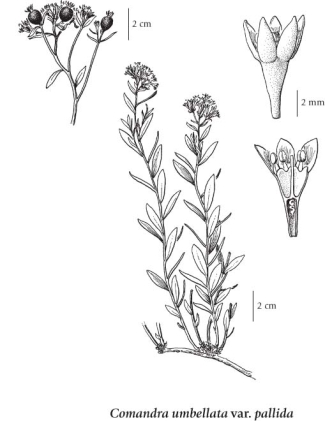Comandra umbellata subsp. pallida (L.) Nutt.
pale comandra
Santalaceae (Christmas Mistletoe family)
Introduction to Vascular Plants
pale comandra
Santalaceae (Christmas Mistletoe family)
Introduction to Vascular Plants
Photograph
© Gordon Neish (Photo ID #23620)
Map
Distribution of Comandra umbellata subsp. pallida
Click here to view the full interactive map and legend
Species Information
General:
Perennial parasitic herb from widespread rhizomes; stems erect, several, clustered, simple, 5-30 cm tall.
Leaves:
Basal leaves lacking; stem leaves alternate, linear-elliptic to lanceolate or widely oblanceolate, entire, short-stalked to nearly unstalked, 5-40 mm long, 1-10 mm wide, thick, fleshy, greenish to glaucous.
Flowers:
Inflorescence of terminal, compact clusters of somewhat bell-shaped; greenish to white or purple, apetalous flowers; calyces tube-shaped with 5 spreading lobes; stamens 1 mm long and hairy at the base.
Fruits:
Berry-like, dry to fleshy, blue to purple or brown, 4-9 mm long.
Notes:
Three varieties are recognized in BC. The vars. californica and umbellata may be difficult to separate.
1. Calyx lobes narrowly lanceolate, (2.5) 3-4 mm long; leaves thick and glaucous, the midnerve sometimes visible (the secondary nerves rarely visible); fruits 6-9 mm long; plants more frequent to the north................. var. pallida (A. DC.) M.E. Jones
1. Calyx lobes narrowly egg-shaped to egg-shaped, (1.5) 2-2.5 (3) mm long (if the lobes 2.5 mm or longer then the leaves usually not glaucous and without visible midnerves); fruits 4-6 mm long; plants of S BC.
2. Leaves somewhat fleshy, usually strongly glaucous, secondary veins usually not visible, the margins rarely rolled towards the underside of the leaves................... var. californica (Eastw. ex Rydb.) C.L. Hitchc.
2. Leaves thinner, usually only slightly if at all glaucous, the secondary veins usually plainly visible, the margins usually slightly rolled under towards the underside of the leaves................... var. umbellata
Illustration

If more than one illustration is available for a species (e.g., separate illustrations were provided for two subspecies) then links to the separate images will be provided below. Note that individual subspecies or varietal illustrations are not always available.
Illustration Source: The Illustrated Flora of British Columbia
Ecology
Ecological Framework for Comandra umbellata ssp. pallida
The table below shows the species-specific information calculated from
original data (BEC database) provided by the BC Ministry of Forests and Range.
(Updated August, 2013)
The table below shows the species-specific information calculated from
original data (BEC database) provided by the BC Ministry of Forests and Range.
(Updated August, 2013)
| Site Information |
Value / Class |
||
|
Avg |
Min |
Max |
|
| Elevation
(metres) |
880 | 484 | 1669 |
| Slope
Gradient (%) |
4 | 0 | 20 |
|
Aspect (degrees) |
129 | 40 | 180 |
| Soil
Moisture Regime (SMR) [0 - very xeric; 4 - mesic; 8 - hydric] |
7 | 3 | 8 |
| Modal
Nutrient Regime
Class |
C | ||
| #
of field plots species was recorded in: |
17 | ||
| Modal
BEC Zone Class |
BG | ||
|
All BEC Zones (# of stations/zone) species was recorded in |
BG(4), ESSF(2), ICH(4), IDF(3), MH(1), MS(2), SBS(1) | ||
|
Source:
Klinkenberg 2013
|
|||
Habitat and Range
Mesic to dry sandy or rocky slopes and shrublands in the lowland, steppe and montane zones; infrequent in NE, SC and SE BC, rare on S Vancouver Island; var. californica - S to AZ and CA; var. pallida - N to YT and NT, E to MB and S to MN, TX, NM AZ, and OR; var. umbellata - N to NT, E to NF and S to ME, PA, NC, GA, MS and OK.Status Information
| Scientific Name | Origin Status | Provincial Status | BC List (Red Blue List) | COSEWIC |
|---|---|---|---|---|
| Comandra umbellata ssp. californica | Native | S3S4 | Yellow | Not Listed |
| Comandra umbellata ssp. pallida | Native | S5 | Yellow | Not Listed |
| Comandra umbellata ssp. umbellata | Native | SU | Unknown | Not Listed |
BC Ministry of Environment: BC Species and Ecosystems Explorer.
Synonyms
Synonyms and Alternate Names:
Comandra umbellata (L.) Nutt.